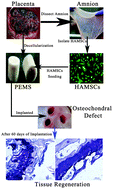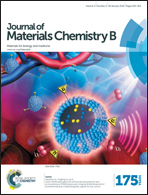Investigating the potential of human placenta-derived extracellular matrix sponges coupled with amniotic membrane-derived stem cells for osteochondral tissue engineering†
Abstract
Osteochondral injuries are challenging to repair due to their complex tissue anatomy and restricted self-repairing ability associated with a limited blood supply. Osteochondral tissue engineering is an important clinical aspect of the management and treatment of cartilage and underlying bone. In the present study, we fabricated human placenta-derived extracellular matrix sponges (PEMS) for repair of osteochondral tissue through a decellularization process. There were no significant cellular components present in the PEMS; hematoxylin & eosin/DAPI staining, DNA quantification and agarose gel electrophoresis were used to evaluate the extent of decellularization. Moreover, no significant alteration to the collagen and glycosaminoglycan (native extracellular matrix) content of the PEMS was observed. PEMS in vitro provided a non-cytotoxic environment rich in bioactive cues for human amniotic membrane-derived stem cells (HAMSCs) to proliferate in and differentiate into chondrogenic and osteogenic lineages under induction. Histological analysis at 28 days after the PEMS were subcutaneously implanted demonstrated no severe immune response in the host and supported the formation of blood vessels. To assess the osteochondral tissue repair ability of PEMS, cell-free PEMS (CFP) and cell-seeded PEMS (CSP) were implanted at osteochondral defect sites in a rabbit model. Histological scores indicated that osteochondral regeneration was more successful in the defects filled with CSP compared to those filled with CFP and empty defects (ED) after 60 days of implantation. In summary, a naturally derived biocompatible scaffold composed of extracellular matrix from human placenta has been successfully developed for osteochondral tissue engineering.

- This article is part of the themed collection: 2015 Journal of Materials Chemistry B Hot Papers


 Please wait while we load your content...
Please wait while we load your content...